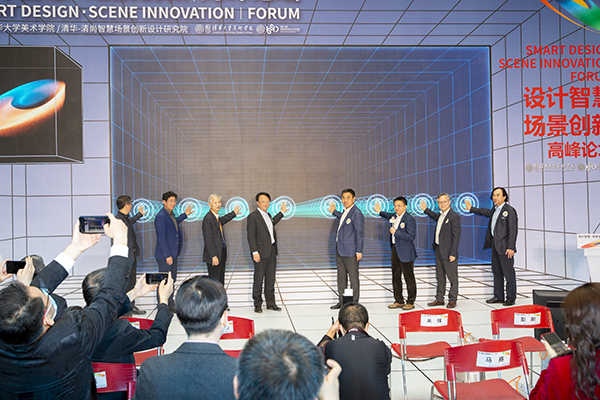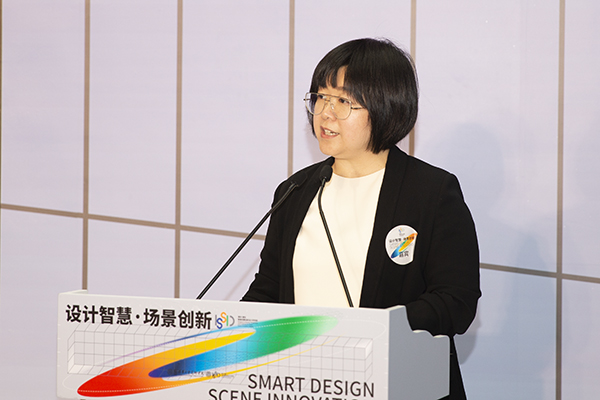Tsinghua launches new design institute blending technology with art
- By Xu Xiaoxuan
 0 Comment(s)
0 Comment(s) Print
Print E-mail China.org.cn, April 22, 2022
E-mail China.org.cn, April 22, 2022

"The integration of art and science has entered a new stage where art and design should facilitate the application of science and technology into modern life," said Professor Wu Qiong with the Academy of Arts & Design at Tsinghua University (AADTHU) at the launch ceremony of Tsinghua University-Tsingshang Joint Institute for Smart Scene Innovation Design (ISSID) on April 19.

The institute's establishment is a major move taken by Tsinghua University to get extensively involved in the national strategy of innovation-driven development, advance the research results as a world-leading university, and accelerate the building of a research center for design and technology innovation with global influence.

"Tsinghua University put forward the integration and innovation of art and science early in 2002. This new institute underscores the combination and application of art and new emerging technologies to serve socio-economic development, improve people's livelihood, and bolster international cultural exchanges," Wu, also deputy director of ISSID, told China.org.cn.
The institute, combined with China's layout of artificial intelligence (AI) and advantages of network configuration, will help people better interact with big data, the Internet of Things, virtual reality, augmented reality, mixed reality, digital twin, 5G, robots and other intelligent technology. In this way, it will present Chinese solutions to contemporary technological issues.
The institute also demonstrates an interdisciplinary approach to making life more agreeable. "As digitalization and IT application are changing the world and shaping the future in an unprecedented manner, the institute will fully harness the advantages of Tsinghua's art design and science and engineering disciplines to create intelligent products to make our lives better," noted Peng Gang, vice president of Tsinghua University.
"Thanks to a long history of development, Tsinghua boasts great strengths in its science and engineering disciplines, including civil engineering, electrical engineering, and energy and power engineering. Integrating art into these subjects can also promote the latter's upgrading in the digital age." Peng added.
Peng also told China.org.cn that the institute could help build a platform for multidisciplinary integration and innovation. "Through the institute, more teachers and students of different disciplines can get together and brainstorm creative ideas, which can be translated and implemented by dint of expertise in various fields."
Zhang Bo, an academician of the Chinese Academy of Sciences and honorary president of the Institute for Artificial Intelligence, Tsinghua University, exemplified the synergy of art and science with AI and architecture.
According to Zhang, consumers' demand for the diversity, individuality, timeliness, precision, and innovation of products requires corresponding prompt responses from the market. This is where AI can and must play a vital role. "For example, the deployment of an algorithm, simulation and 3D painting in designing a construct can help provide a myriad of solutions in multiple forms with high efficiency to cater to the mass market."
Art and design entail emotional investment and should bring about aesthetic value, and whether computer programs or AI algorithms can produce creative solutions may come into question. Zhang suggested that man-machine interactions should be strengthened and that AI should be complemented by the polishing and refinement of artists' expertise and experience.
ISSID currently consists of professors from the AADTHU and experts and academicians in relevant domains. According to Wu, the institute will attract and recruit more talent and involve capable students. In addition, the institute aims to foster versatile professionals with scientific spirits, top-notch aesthetic judgment, and systematic expertise in line with the country's social, economic, and cultural development.
After the launch ceremony, a forum themed on smart design and scene innovation was held where insights were shared by experts and scholars from the Chinese Academy of Engineering, China Aerospace Science and Technology Corporation, Beijing Institute of Architectural Design, Intel Labs China, Tencent, Huawei, and Lenovo, among others.






Go to Forum >>0 Comment(s)